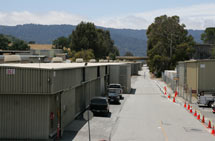
Handy Links
SLAC News Center
SLAC Today
- Subscribe
- Archives: Feb 2006-May 20, 2011
- Archives: May 23, 2011 and later
- Submit Feedback or Story Ideas
- About SLAC Today
SLAC News
Lab News
- Interactions
- Lightsources.org
- ILC NewsLine
- Int'l Science Grid This Week
- Fermilab Today
- Berkeley Lab News
- @brookhaven TODAY
- DOE Pulse
- CERN Courier
- DESY inForm
- US / LHC
SLAC Links
- Emergency
- Safety
- Policy Repository
- Site Entry Form

- Site Maps
- M & O Review
- Computing Status & Calendar
- SLAC Colloquium
- SLACspeak
- SLACspace
- SLAC Logo
- Café Menu
- Flea Market
- Web E-mail
- Marguerite Shuttle
- Discount Commuter Passes
-
Award Reporting Form
- SPIRES
- SciDoc
- Activity Groups
- Library
Stanford
Around the Bay
SLAC Puts Federal Stimulus Funds to Work

Signed by Congress and President Obama in late February, the American Recovery and Reinvestment Act has already brought $57.4 million in scientific and infrastructure projects to SLAC National Accelerator Laboratory. Including projects that are now progressing through Department of Energy approvals, the total could nearly double. In the first months since the stimulus bill became law, the lab has moved swiftly to put the stimulus funds to work, efficiently and transparently, to advance SLAC science.
The first step was identifying the right projects. SLAC sent carefully selected proposals for review by the Department of Energy's Office of Science.
"The projects selected had to be shovel-ready, and improve the lab's mission readiness or increase our science capabilities," said SLAC Deputy Director for the Linac Coherent Light Source Mark Reichanadter, who is acting as core group lead for the lab's ARRA projects. Six projects are progressing through reviews and approvals; four of them are already fully funded.
In the initial months after ARRA was announced, SLAC has set up the project management and finance structures to assure focused and traceable progress. The newly formed SLAC Project Management Office, led by Elizabeth Dahlen, established consistent procedures for ARRA efforts. Each ARRA project has a federal project director from the DOE Site Office, as well as a SLAC project manager and financial and purchasing support. Together, these project teams created project management plans defining what work will be done, how risk will be managed, purchases to be made and personnel needed. The result is a carefully defined and trackable work plan for each ARRA project.
"We're pretty much done with the planning phase," Reichanadter said. "We've got the teams, project management and resources in place. Now we're getting ready to authorize the projects… and start digging into the real work."
The first round of funding includes $33.6 million to speed construction of science instruments for the Linac Coherent Light Source. The LCLS, the world's first hard X-ray laser, will see its first scientific experiments late this summer, on the first of six proposed scientific instruments. The ARRA funds will accelerate completion of four additional instruments, so that more researchers can use the LCLS for a broader array of experiments, sooner.
Also among the first SLAC ARRA projects to be fully funded are several infrastructure improvements. A replacement and upgrade to three electrical substations, and general infrastructure improvements and seismic upgrades to the Stanford Synchrotron Radiation Lightsource will help to modernize some of the lab's older infrastructure and support ongoing science for years to come.
The remaining projects up for DOE approvals this summer include a second round of funding for FACET—the Facilities for Accelerator Science and Experimental Test Beams—a center for advanced accelerator research using the first two-thirds of the SLAC linac. Also in reviews is the sixth LCLS science instrument, which will study materials in extreme conditions.
It's too early to say how many jobs the new projects will support, but it's clear the stimulus bill is already having a positive impact.
"The ARRA projects have had an energizing effect at SLAC," said lab Director Persis Drell. "The stimulus funds are already going to work here, advancing SLAC's scientific mission and the infrastructure that supports it."
—Shawne Workman
SLAC Today, June 29, 2009
